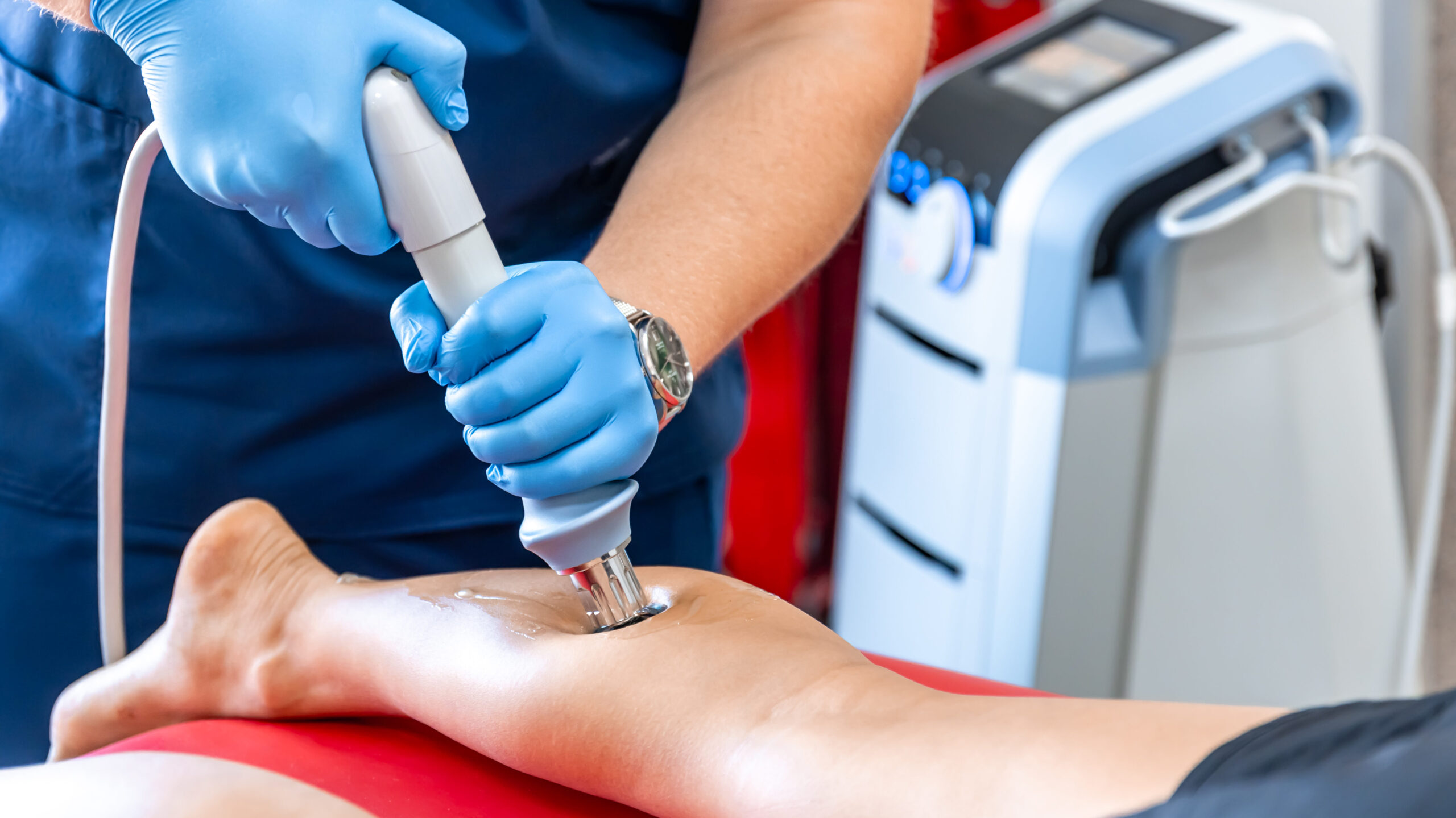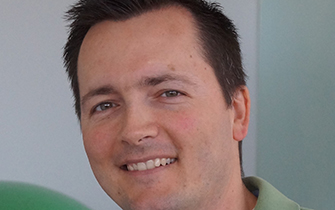What is shockwave therapy?
Shockwave therapy, also known as extracorporeal shockwave therapy (ESWT) or radial shockwave therapy, uses a specialized device to deliver extremely high-frequency sound waves, or shockwaves to the injured tissues. These shockwaves promote circulation, break down scar tissue, and trigger stem cell activation, making it an ideal solution for chronic or longstanding musculoskeletal conditions.

- Non-surgical and drug-free
- Effective for hard-to-treat conditions like plantar fasciitis and calcific tendinitis
- Often used in sports rehabilitation and physical therapy
Our trained physiotherapists provide shockwave therapy treatments at our clinic in St. Albert, serving Edmonton, Morinville, Gibbons, Barrhead, Westlock and other surrounding areas.
Like all of our treatments, this treatment may be just one part of a larger, customized wellness plan made just for you.
How does radial shockwave therapy work?
Using a pneumatic generator, we deliver shockwaves to the affected area through a handheld device. These mechanical pressure waves penetrate deep into tissues, stimulating increased blood flow and encouraging tissue regeneration.
Despite its name, shockwave therapy doesn’t involve electric shocks. Most clients describe it as a strong tapping or deep vibrating sensation.
Treatments are typically:
- 15 minutes per session
- Once per week
- Completed over 3–5 sessions
At Summit Physiotherapy, we use the trusted EMS Swiss DolorClast machine, known for its precision and effectiveness and is considered to be the benchmark instrument in its field. It has a handheld device that your physiotherapist will apply to the affected area to deliver the shockwaves.
What conditions can shockwave therapy treat?
Shockwave therapy is commonly used to treat:
- Achilles tendinitis
- Rotator cuff injuries and tendinitis
- Tennis elbow / Golfer’s elbow
- Wrist tendinitis (De Quervain’s Syndrome)
- Calcifications
- Plantar fasciitis / heel spurs
- Frozen shoulder (adhesive capsulitis)
- TMJ (jaw pain)
- Hip and shoulder bursitis
- Shin splints
- Trigger finger
- Scar tissue and muscle tightness
- Jumper’s knee / Patellar tendonitis
- Big toe joint pain / Bunions
- Arthritis
It is also a popular treatment for sports injuries and overuse conditions.
If you’re experiencing pain book a consultation with one of our knowledgeable physiotherapists. Our team has years of experience in using shockwave therapy in clinical practice. We will be able to determine whether it’s the right choice for you.
What are the benefits of shockwave therapy?
Shockwave therapy is a non-invasive treatment.
Shockwave therapy is a safe and simple treatment that is administered in our clinic. Your physiotherapist simply presses a small tool (handpiece) into the area where you’re experiencing pain or where the pain is coming from. The handpiece sends shockwaves, which you’ll feel as deep vibrations into the tissues being treated.
Shockwave therapy treatment sessions are quick to complete!
We know how hard it can be to fit treatment into your busy schedule. Shockwave therapy is such a great option since it’s so quick to administer.
Shockwave therapy treatments can be completed in just 15 minutes per session, so you can get on with your day. In most cases, there is very little post-treatment soreness.
Shockwave therapy is often used in conjunction with other physiotherapy treatment techniques such as, IMS (intramuscular stimulation), acupuncture, myofascial release and massage therapy as well. Home exercises and stretches will also be suggested to help in the healing process.
Only 4-5 shockwave therapy treatments are needed.
There are very few types of treatments which result in such fast success as shockwave therapy. You may need as few as three treatments to see a marked improvement in your mobility and pain. Most of our clients need 4-5 sessions on average. It’s unlikely that you’ll need more than five.
No effort is required by the client.
A key aspect of most physiotherapy programs is active participation, but shockwave therapy requires no effort by you at all. Our therapists will also provide knowledgeable instruction on what should be done or not following a shockwave treatment. Home stretches and exercises are usually given to help with your rehabilitation.
Shockwave therapy treats a variety of conditions.
Shockwave therapy has been successful in treating many conditions from tendinitis and arthritis to heel spurs and frozen shoulder. Since it’s so effective at breaking up calcium deposits and stimulating greater blood flow, you will see faster healing times for all kinds of injuries and recurring conditions.
Shockwave therapy has a high success rate!
We’ve seen amazing success in treating our clients with shockwave therapy. It’s an effective tool in our physiotherapy arsenal because of its ability to speed healing. We feel confident recommending shockwave therapy to a variety of people because of its strong track record.
How much does shockwave therapy cost?
At Summit Physiotherapy in St. Albert:
- $120.00 per session
- $180.00 per session for two injury sites.
Shockwave therapy is typically covered under extended health benefits as a physiotherapy treatment. Contact your provider to confirm your coverage.
Let’s build your customized treatment plan!
If you’re experiencing any type of pain, our team can help. After an assessment with a trained physiotherapist, you’ll receive a customized treatment plan. Shockwave therapy may be part of that plan, but we’ll only recommend the treatments that are right for your unique body and injuries.
Shockwave therapy can be used in conjunction with massage therapy or other physiotherapy treatments such as IMS, acupuncture, myofascial release and home exercises.
Why Trust Summit Physiotherapy for Your Health and Wellness?
Locally owned and proudly serving St. Albert for over 42 years!
Our therapists have over 148 years of combined experience in physiotherapy and massage therapy!
Personalized, one-on-one ‘hands-on’ approach for every patient, every visit.
We use evidence-based techniques and the latest technology for effective pain relief and recovery.
4.7 star rating from our satisfied clients.
We focus on long-term solutions – not just quick fixes.
Home exercise programs are customized for each client to ensure continued progress.
Our services are covered by insurance, making quality care accessible to everyone.
Convenient access to care is just a call or click away.
Find a Shockwave Physiotherapist
Not sure which member of our team to work with? We can help! Contact our clinic today.
Frequently Asked Questions
What does shockwave therapy feel like?
Most people describe the sensation as a strong tapping or deep vibration in the treated area. It can feel intense, especially in the first few minutes, and is usually uncomfortable or slightly painful. Any post-treatment soreness is usually mild and temporary. The intensity of the shockwaves is adjusted to accommodate the client’s injury and pain tolerance.
Is shockwave therapy safe?
Shockwave therapy is extremely safe. It simply delivers a high-density sound wave directly to your tissues muscles, and bone. It is not invasive or aggravating. It simply stimulates your body’s natural healing processes.
Can shockwave therapy treat plantar fasciitis?
Yes. Shockwave therapy is extremely successful in treating plantar fasciitis and heel spurs. Plantar fasciitis is an inflammation of the ligament that connects your heel and your toes. This strain happens over time due to things such as improper footwear, repetitive impact, or excessive pronation.
In combination with shockwave therapy, your physiotherapist may recommend other effective treatments to work hand-in-hand to assist in recovery and to help prevent future injuries. Intramuscular stimulation (IMS), acupuncture, taping and myofascial release are common treatments we provide for treating plantar fasciitis.
Can shockwave therapy treat TMJ?
Yes, shockwave therapy can be used as part of a treatment plan for TMJ (temporomandibular joint) disorders. It works by targeting the muscles and tissues around the jaw joint to reduce pain and muscle tension. For individuals who have chronic jaw pain, difficulty chewing or clicking, shockwave therapy may help improve mobility and promote healing without the need for invasive procedures. However, it’s important to have a proper assessment first to determine if this therapy is right for your specific TMJ condition.
Does shockwave therapy work for knee pain?
Yes, shockwave therapy can be effective for treating most types of knee pain, especially chronic conditions like patellar tendinopathy (jumper’s knee), osteoarthritis, IT Band syndrome, bursitis or calcifications around the joint. It works by delivering intense acoustic waves to the affected area, stimulating blood flow and promoting tissue repair. However, results can vary depending on the cause and severity of the knee pain. It’s often used alongside other treatments like exercise therapy for the best results.
What are the drawbacks of shockwave therapy?
While generally safe, shockwave therapy does have some potential drawbacks:
- Temporary discomfort or pain during or after treatment.
- Redness, swelling, or bruising at the treatment site.
- It may require multiple sessions for noticeable results.
- Not suitable for everyone (e.g., people with blood clotting disorders or certain nerve issues).
- Effectiveness can vary based on the condition being treated and the individual’s overall health.
Always consult with a physiotherapist to determine if it’s appropriate for your specific case.
Does shockwave therapy actually work?
Yes. Clinical studies show that shockwave therapy is effective in treating chronic soft tissue injuries. It’s particularly successful in treating plantar fasciitis, tendinitis, and calcific shoulder issues, with success rates as high as 90% in some cases (source).
How is shockwave therapy performed?
A physiotherapist uses the handheld device (handpiece) attached to the pneumatic generator and presses it against the area of your body that requires treatment. The handpiece is used with ultrasound gel and is moved around in a steady motion to consistently treat the entire area.
The entire treatment takes less than 15 minutes, and may be repeated 4-5 times over a month or so. If shockwave therapy is used in conjunction with other physiotherapy treatments it will take longer and may be up to 45 minutes.
What is the difference between ultrasound and shockwave therapy?
Both ultrasound and shockwave therapy are non-invasive treatments used to promote healing, but they work in different ways:
- Ultrasound therapy uses high-frequency sound waves to generate deep heat in soft tissues, which can increase blood flow, reduce muscle spasms, and help with tissue relaxation.
- Shockwave therapy on the other hand, delivers high-energy acoustic waves (shockwaves) directly to the affected area. It stimulates cellular repair, breaks down scar tissue or calcification, and promotes new blood vessel formation.
In short, ultrasound is more about gentle deep heating, while shockwave therapy delivers mechanical energy for deeper, more targeted tissue regeneration—especially helpful in chronic or hard-to-treat conditions.
Is shockwave therapy better than acupuncture?
Shockwave and Acupuncture are completely different types of treatment so it is very hard to compare the two treatments. Whether one type of treatment works better than the other, depends on the condition and the individual. Both treatments offer benefits, but they work in very different ways:
- Shockwave therapy is ideal for treating chronic soft tissue injuries, tendonitis, and muscle tightness by stimulating the body’s natural healing response.
- Acupuncture focuses on balancing the body’s energy flow and is commonly used for pain relief, stress, and a range of physical and emotional conditions.


